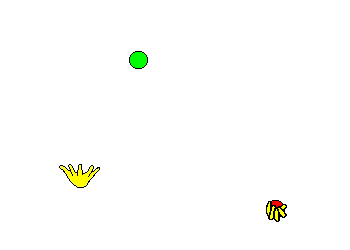Previous Next
Asych theory menu Contents

Three Ball Gap If you drop a ball while juggling a three ball cascade you end up juggling a three ball gap. The throwing sequence for this pattern is right, left, gap, left, right, gap,... where the gap is an empty hand. The throws in this pattern are the same as the throws in the three ball cascade, they are 3s. The gap is represented by a 0, since the hand could throw a ball but has no ball to throw. So the three ball gap can be written: Throwing hand: R L R L R L
It can be written more simply as: 330. If you follow the path of a ball in this pattern, you'll see that it is thrown every two throws. Despite this the throws are still 3s. To see why, we need to revise our definition of a 3. In asynchronous patterns, when one hand throws the other hand catches (you can see this in the three ball cascade animation). The moments when the hands can throw or catch a ball are called beats. A 3 is a throw that allows the same ball to be thrown again three throws later (ie three beats later). So a 3 must be caught two beats later. The throws in the three ball gap are caught two beats later, so they are 3s. If you take the average of the throws 3,3 and 0, you get: (3+3+0)/3=2 The three ball gap is a two ball pattern. For any siteswap pattern the average of the throws tells you how many balls you will need to juggle it. |